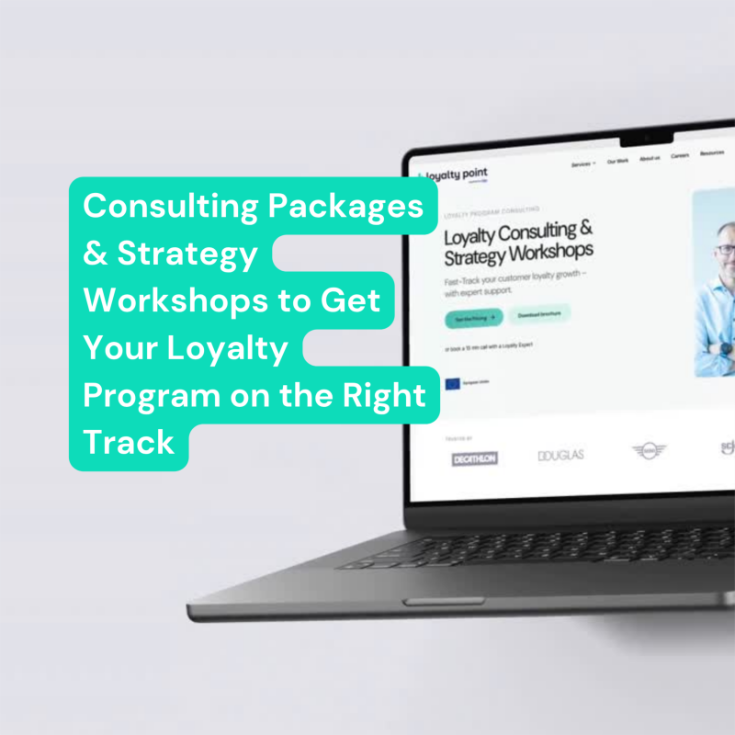What Resources Are Needed to Successfully Launch a Loyalty Program?

Launching a loyalty program is a complex, multi-faceted process that requires the engagement of numerous departments. Where do you begin? What resources must you have at your disposal to ensure such a project ends in success, rather than becoming a costly failure?
The effective launch of a loyalty program doesn't hinge on the size of your budget, but on the strategic mapping and preparation of its core pillars: human, technological, financial, operational, and strategic resources. Furthermore, a modern approach reveals that this doesn't have to be a massive, one-time investment. Instead, it can be a process that starts with smaller, scalable steps.
In this article, we will guide you through the process of identifying and planning these crucial resources. We'll show you how to map them effectively to build a solid foundation for a program that delivers real value.
How to Map Resources That Are Needed to Run a Loyalty Program?
Before launching a loyalty program, it's essential to understand not only what needs to be done, but also who will do it and how the program will be sustained. Resource mapping involves identifying all the key roles, skills, tools, and processes necessary to effectively design, implement, and manage the program. competency gaps. This approach not only facilitates better planning but also helps you avoid common pitfalls that arise from underestimating the project's needs.
Even when the necessary skills are available internally, it is critical to assess whether your teams have the operational bandwidth to commit to the project. Often, the biggest barrier is not a lack of knowledge, but a lack of time.
5 Steps to Identify Resources for Your Loyalty Program Launch
Step 1: Define the Business Objectives You Want to Impact
Before you start allocating resources, you must know what you want to build. What is the primary goal of the program? Is it to increase customer retention, boost purchase frequency, or acquire valuable first-party data? Clear objectives will dictate your resource needs.
Step 2: Develop the Initial Mechanics and Unique Value Proposition (UVP)
This forms the starting point for outlining the resources required for subsequent stages. It's crucial to validate your proposed mechanics and UVP with senior management and the finance department to ensure alignment and feasibility.
.png)
Step 3: Conduct an Audit of Your Existing Resources (Internal Audit)
Take stock of what you already have within your company.
- People: Do we have employees with the right skills? Can they dedicate a portion of their time to this new project?
- Technology: Does our current CRM or e-commerce platform have a loyalty module? Do we already have email marketing tools that can be leveraged?
- Processes: Can existing customer service procedures be easily adapted to support the program's needs?
Step 4: Create a Cross-Functional Project Team
Assemble representatives from key departments: marketing, sales, IT, customer service, and finance. Each member will bring a unique perspective and help identify the resources needed within their domain. Ensure the team considers the nuances of both physical points of sale and e-commerce operations.
Step 5: Identify Gaps and External Needs
Based on your audit, pinpoint what is missing. This is the moment to make decisions:
- Do we need to hire a new person (e.g., a Loyalty Manager) or train the current team?
- Should we purchase a new loyalty platform or commission the development of custom software?
- Is support from an external marketing agency needed to promote the program launch?
This systematic approach is designed to prevent a costly and disruptive scramble later on, ensuring every requirement is matched with a corresponding resource—an effort that directly sets the stage for resource mapping.
Planing to Avoid Failure: The Role of a Resource Map
Failing to prepare is preparing to fail. Skipping the resource mapping stage can lead to a host of problems, including budget overruns, implementation delays, and poor operational performance. Effective mapping not only helps in estimating costs but also allows you to identify potential bottlenecks and skill gaps before they become critical issues. The key is to think of a loyalty program not as a one-off project, but as a living organism integrated into your company's ecosystem, one that requires a constant supply of the right resources to thrive.
What Resources Are Essential for a Loyalty Program Launch?
Launching a loyalty program isn't just about a great idea and a solid strategy—it's about the tangible resources you identify, plan for, and allocate. Here is a breakdown of the key areas to consider before you begin implementation, from the team and technology to the budget and day-to-day operations.
Human Resources – Who Will Be Responsible for the Loyalty Project/Area?
Before you decide to launch, it is crucial to prepare your team and assign clear roles. A program implementation is a cross-functional project that demands a clear structure of responsibility and seamless collaboration between departments.
- Loyalty Program Owner (e.g., Marketing Team or a dedicated Loyalty Manager): Identify one person who will hold the overall vision, be responsible for the strategy, and coordinate all activities. Will this be a dedicated specialist, or will the role be assigned to the Marketing or E-commerce Director?
- IT Team / Developers: Responsible for integration, system maintenance, application support, and APIs. They handle the critical task of integrating the loyalty platform with existing systems like your e-commerce site, CRM, and POS. Furthermore, they are responsible for ensuring data security, maintaining system performance, and troubleshooting any technical issues that arise.
- Data Analysts: Tasked with measuring effectiveness, customer segmentation, and reporting. Their role goes beyond simple reporting. Data analysts translate data into actionable insights to optimize the program's performance. They monitor metrics like redemption rates and customer lifetime value to identify trends and recommend data-driven improvements.
- Marketing Team: Responsible for all communication, promotional campaigns, content creation, and member onboarding. This team is the voice of the program, crafting the messaging and creative assets that attract and engage members. They manage multi-channel communication, from welcome emails to social media campaigns, ensuring the program's value is clearly and consistently conveyed.
- Customer Service Team: The front line for supporting program members with their inquiries and issues. They must be well-trained in all program rules to handle questions about points, rewards, and technical difficulties effectively. This team plays a vital role in shaping the member's experiences and serves as a valuable source of direct customer feedback.
- Sales / Operations Team: Ensures the program is smoothly integrated with sales processes, both online and in-store. This includes training front-line staff, such as cashiers, on how to enroll new members and apply rewards at the point of sale. Their work ensures that the customer's interaction with the loyalty program is seamless and hassle-free.
- External Partners: This may include agencies, loyalty platform providers, graphic designers, or consultants. These partners provide specialized expertise or technology that you may not have in-house. A platform provider supplies the core software, while an agency might be hired to develop the creative strategy, accelerating implementation with expert knowledge.
Technological Resources – What Will Your Loyalty Program Run On?
This phase is dedicated to analyzing and selecting your loyalty platform. You'll need to choose between a ready-made SaaS solution and a custom-built system. Map out the integration possibilities with your existing ecosystem (e-commerce, POS, CRM) and plan your data architecture to ensure your systems are ready to collect and process customer data effectively.
- Loyalty Platform: Choose between a turnkey SaaS solution and a custom system. Your choice here will define the program's flexibility and long-term potential. A SaaS platform offers speed and proven features, while a custom build provides a unique competitive advantage but requires significant internal resources to maintain and scale.
- Integration with Core Systems: Ensure seamless connection with your CRM, e-commerce platform, POS systems, and mobile application. This is non-negotiable for creating a unified customer view and delivering a consistent experience across all touchpoints. Without proper integration, you risk data silos and a clunky user journey, where points earned online might not be visible in-store.
- Marketing Automation System: You need a system for email marketing and marketing automation (e.g., for emails, push notifications, SMS) that allows for database segmentation and personalized communication with members. This tool is the engine for member engagement, allowing you to send the right message at the right time. By leveraging behavioral triggers, you can automate personalized communications like birthday offers, reward reminders, or special promotions for at-risk members.
- Data Infrastructure: Verify that your current systems can collect and integrate customer and transaction data into a single location (e.g., a CRM or a Customer Data Platform - CDP). This is the foundation upon which personalization and analytics are built, creating a single source of truth for each member. A robust data infrastructure ensures you can accurately track behavior across channels and use that information to refine your program strategy.
- Dashboards and Analytics Tools: To monitor performance, track KPIs, and generate reports. These tools make program data accessible and understandable for key stakeholders, moving beyond raw numbers to visual trends. They are essential for demonstrating the program's ROI and for making informed, data-driven decisions on future optimizations.
Financial Resources – How Much Will It Cost?
For marketing managers tasked with launching such an initiative, a budget is not just a list of expenses. It is a business case—a roadmap that outlines the initial investment, forecasts ongoing operational needs, and, most importantly, projects the financial return. This process can be broken down into two distinct phases: the upfront capital expenditures (CAPEX), estimate the one-time implementation costs, such as license purchases, development, and integrations to build the program, and the recurring operational expenditures (OPEX) to sustain and grow it, including the value of rewards, licensing fees, and the marketing budget.
- Implementation
One-time costs refer to the initial expenses required to set up and launch a project or solution. These include fees for purchasing software licenses, as well as investments in development and tailoring the technology to specific business needs. Another important component is the cost of integrating the system with existing tools to ensure smooth and efficient operation. Additionally, one-time costs cover the creation of launch assets, such as graphics, promotional content, and other creative materials that support the project’s introduction.
Often overlooked are the costs associated with internal training and rollout. Your customer service team must be equipped to handle inquiries, and your frontline staff must become enthusiastic advocates for the program. This requires developing training materials and dedicating time to ensure the entire organization is aligned for a smooth launch. Finally, legal and compliance costs are non-negotiable. Crafting a clear and fair terms-of-service agreement and ensuring full compliance with data privacy regulations like GDPR is essential to build trust and avoid legal pitfalls.
- Operational Budget (OPEX)
The operational budget (OPEX) represents the ongoing monthly or annual expenses required to keep the program running smoothly. It includes the liability cost, which reflects the value of points or rewards that have been issued but not yet redeemed, as well as the actual cost of rewards and benefits that members claim, such as products, discounts, or services. Another important component is the marketing and communication budget, which covers promotional activities and engagement with the member base to maintain interest and loyalty. In addition, operational costs account for logistics, customer service, and other day-to-day processes that ensure the program functions effectively. The budget also encompasses platform and maintenance costs, including licensing fees, hosting, and technical support needed to sustain the system. Finally, a contingency fund is set aside to provide financial flexibility and cover any unforeseen expenses that may arise.
Before you spend, calculate the potential return. Services like ROI Forecasting & Financial Impact Modeling can estimate the potential return on your loyalty program investment. A financial model and risk analysis will provide you with the hard data needed to make an informed decision.
Operational Resources – How to Weave It into Daily Business?
Develop the processes and procedures that will govern the program, from member enrollment and point accrual to handling returns and complaints.
- Processes and Procedures: Establish clear rules for key processes: How does a customer join? How are points calculated? What happens when an item is returned? How are member inquiries handled? These documented workflows ensure consistency across all touchpoints and minimize operational friction for both customers and staff. They translate the strategic vision of the program into reliable, day-to-day actions.
- Team Training: Prepare and conduct training for front-line employees (in-store staff, customer service agents) so they can confidently manage the program and encourage participation.Effective training is crucial, as the front-line team acts as the program's most direct advocate and knowledge source for customers. This investment ensures staff can seamlessly enroll members, apply rewards, and troubleshoot common issues, turning every interaction into a positive brand experience.
- Terms & Conditions and Legal Aspects: Allocate budget and time for legal consultation to prepare program regulations that comply with all relevant laws (e.g., GDPR, consumer rights). Clear, fair, and legally compliant Terms & Conditions build customer trust and mitigate significant legal risks, particularly regarding data handling and privacy. This includes explicitly defining liability for unredeemed rewards and ensuring transparency about how customer data will be used within the program.
- Project Management: Loyalty programs often require dedicated project management. At agencies like ours, we can take on this responsibility to ensure a smooth rollout. A dedicated Project Manager (PM) is essential for orchestrating the cross-functional efforts of IT, Marketing, Operations, and external vendors. The PM maintains timelines, manages the budget, tracks dependencies, and acts as the central point of communication to drive the implementation to a successful, on-time launch.
Strategic Resources – How Will the Program Run and Evolve?
Even before implementation, it's wise to plan for the program's long-term development and prepare for a growing customer base. The goal isn't just to launch a program, but to consistently maintain its appeal to consumers over time.
- Long-Term Program Strategy: Define goals, KPIs, and a development roadmap. This ensures the program is aligned with your broader business objectives and can adapt as the market changes. A clear strategy also helps prioritize investments and resources, making it easier to scale in a structured way. You can find an overview of the most important KPIs on our blog in the article Best Loyalty Metrics: KPIs to Measure Program Success and Drive Engagement.
- Segmentation and Personalization: Plan how you will tailor offers to different customer groups. By leveraging customer data, you can create targeted incentives that feel relevant and valuable to each segment. Over time, personalization builds stronger emotional connections and increases customer loyalty.
- Feedback and Iteration Mechanisms: Establish processes for listening to users and evolving the program based on their feedback. Regularly gathering insights from customers allows you to identify gaps, test new ideas, and refine offers. This continuous improvement loop ensures the program remains engaging and competitive in the long run.
How to Start a Loyalty Program Without a Huge Investment
A loyalty program is not a sprint. It is a marathon. Many managers postpone the decision to implement a loyalty program, fearing massive one-time costs and a complex, resource-draining project. This is a misconception rooted in outdated thinking. A loyalty program can be built in stages, starting with a Minimum Viable Program (MVP).
- Start with Segmentation: First, understand who your customers are and which segments would resonate most with a loyalty offering.
- Introduce Simple, Trust-Building Mechanics: Instead of complex gamification and multi-level statuses, start with a simple "earn points, get discounts" mechanism or a digital punch card program.
- Test and Learn: An MVP allows you to gather invaluable data on customer behavior at a low cost. You can see what works and what doesn't before investing in more advanced features.
- Evolve the Program Based on Data: By analyzing the initial results, you can make informed decisions about the next steps. Should you add new rewards? Introduce status tiers? Or invest in personalization? This evolutionary approach is far more financially sound.
Loyalty Program Consulting and Strategy Workshops – An Expert at the Start

Just as you would consult a specialist when preparing for a marathon, it's wise to do the same for your loyalty program. For companies that want to approach the topic strategically without immediately incurring huge costs, consulting services are the ideal solution – a "door-opener" to the world of professional loyalty. Consider services like:
- Organization Readiness Assessment: Before you start, check if you're truly ready. This service assesses whether your organization has the right structures, resources, and processes to effectively implement a loyalty program, helping you build a solid foundation and avoid common mistakes.
- Loyalty Program Development Map: Launching a loyalty program involves many moving parts – from setting clear goals to aligning technology, marketing, and reporting. Our Loyalty Program Development Map simplifies this process by providing a structured, step-by-step consulting framework. Through stakeholder workshops, process mapping, and a review of your existing tools, we deliver a practical roadmap with best practices and minimum technology requirements to help you launch with clarity and confidence.
- Competitive Benchmark & UVP Validation: Before investing in a new loyalty program, it’s crucial to understand its market potential and how it stacks against competitors. Our Competitive Benchmark & UVP Validation service helps you do just that by combining consumer research with industry benchmarks. The result is a detailed report with actionable insights on offer design, reward structures, and clear recommendations to ensure your program resonates with customers. With this approach, you can craft a loyalty strategy that stands out, delivers real value, and keeps customers coming back.
- ROI Measurement Setup for Your Business Case: Measuring the financial impact of a loyalty program is essential to ensure it drives real value instead of draining resources. By evaluating ROI before launching, you can make informed investment decisions and clearly understand the balance between customer engagement and profitability. With our ROI Modeling service, we help you build a tailored ROI model, identify your break-even point, and highlight key drivers and potential risks. The result is a transparent financial framework that takes the guesswork out of planning and gives you the confidence to scale your loyalty program strategically.
These are just examples of small steps to take before launching a loyalty program. You can find a complete Loyalty Program Consulting services on our website.
Case Study: How Intermarché Prepared for Its Loyalty Program Launch
To understand how a major brand approaches implementation, look at the case of the supermarket chain Intermarché. Before launching a new program, the company initiated a comprehensive project to prepare the organization. This involved in-depth workshops with key stakeholders from various departments, an analysis of the existing technological ecosystem, and a review of internal processes. The goal was to identify opportunities, pinpoint potential challenges, and align the entire organization around a shared vision for the future of customer loyalty. The outcome was a set of concrete, actionable recommendations for the future direction of loyalty at Intermarché, tailored to the brand's unique characteristics and values, ensuring they were fully prepared for a successful rollout. You can read more about A Strategic Blueprint for Intermarché’s Customer Loyaltyin the Our Work section.
Summary: Smart Loyalty Program Launch Begins with Mapping Resources and Business Goals
Launching a loyalty program is a strategic decision that can yield immense benefits. As we've shown, the key to success is not having unlimited resources, but consciously planning them across four critical areas: people, technology, finances, and operations.
Remember, you don't have to build the most advanced system on the market from day one. An evolutionary approach, starting with an MVP, minimizes risk and allows you to build a program that genuinely meets the needs of your customers. And with the support of external experts, even the first, most challenging step becomes significantly simpler. A well-prepared plan is the best investment you can make in the future loyalty of your customers. Are you ready to create yours?
See also



.jpg)